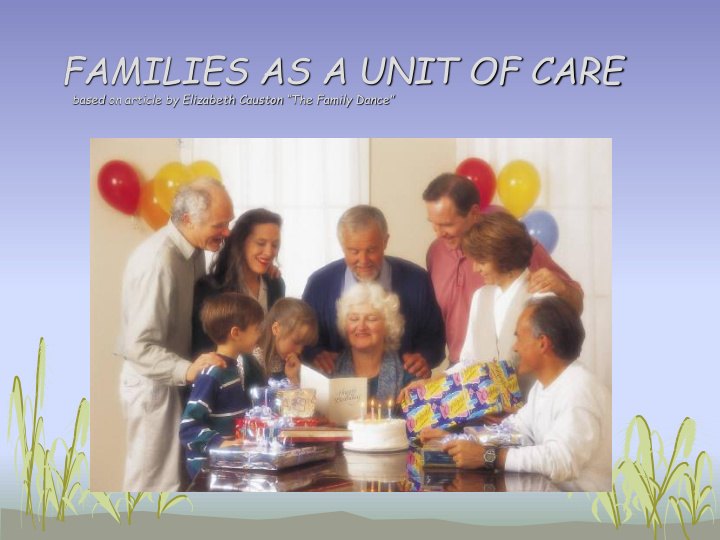



FAMILIES AS A UNIT OF CARE based on article by Elizabeth Causton “The Family Dance”
Session Objectives To explore and discuss “family” as a unit of care To increase awareness of changing needs and issues around end of life care and pre-death loss
“ What is “Family”? C anadian Palliative Care Association : “those closest to the patient in knowledge, care and affection.” This includes the biological family, the family of acquisition (related by marriage/contract) and the family of choice and friends (not related biologically, or by marriage/contract)”.
The most practical approach to defining family affected by a person’s illness or a death…. • Is to permit individuals and their family members to self- define “who” constitutes the individual’s “family”
Systems Approach • Family systems approach, simply stated: “Family members make up the family system; a change in one part of the family system naturally changes the rest of the system.”
The “Family Dance” A Metaphor
Families know best…………… • The dance of each family has developed over time (historically) and has a reason for being the way it is. Some dance moves may actually serve a positive and protective function for family members — and as an observant volunteer, we won’t know which dance moves these are.
Hospice Volunteers and “The Dance” As we honour families, we can remind ourselves that: Every family has a dance that they participate in together Each family member has his or her own steps and they generally know how to move with one another.
Dance moves………… i.e. (behaviour) of each partner engages and maintains the moves (behaviour) of the other. May or may not be graceful or in time with the music, however, it is a dance that is familiar to that particular family and all of its’ members
In our role as compassionate observers, we may have an opportunity to share our understanding of the natural responses to illness and grief. • The naturalness of the multitude of feelings when one’s own dance steps are interrupted. • The naturalness of the feelings of fear, sadness, anger or confusion when one person in the family begins to dance away and may no longer be a participant in the family dance….
Compassionate observers…… As volunteers, we may have the honour and privilege of being invited to watch a family’s dance as one member begins to do his or her steps differently due to illness or grief. This may be a time when the whole dance changes especially if one member has to sit down on the dance floor.
In our role as compassionate observers, we may have an opportunity to share our understanding with family members of: • The naturalness of tears that may cause family members to stumble on the dance floor. • The naturalness of frustration for each family member if or when an ill or bereaved member sits on the dance floor and everyone else must change their steps to accommodate them.
Learning new dance steps takes time and practice. • In family relationships, one member cannot make another member change his or her steps. • Or family members may or may not choose at this time to remain on the dance floor with one another.
Family stress may increase as each member tries to adapt to changes • Dance music generally gets faster and louder in crisis……. • Changing steps may seem clumsy, and feet, as well as feelings, may easily or even unavoidably be stepped on causing pain and discomfort to all concerned.
Signs That We May be on an Individuals or Family’s Dance Floor Extremes of Emotional Responses Circle of Friends Control the Individual or Family
If we forget our role as observer and step out on to the family dance floor • We may be only able to see the person next to us and a bit farther, therefore we cannot bear witness to the whole family’s dance • We may risk bumping into family members who are trying to learn to dance differently with one another • We may not be able to provide valuable “outside perspective” when invited to share our observations.
Having a palliative family member impacts on the entire family in the following ways : 1. Family members’ health 2. Family Communication issues 3. Psychological issues -meaning of illness -feelings of loss/threatened loss -isolation – physical/emotional/spiritual
Impacts (cont’d)_ 4. Needs of information 5. Physical care demands 6. Family costs of caring
When we observe the family dance, it is a great time to practice the 4 Agreements • Be impeccable with your word • Don’t take anything personally • Don’t make assumptions • Always do your best
As volunteers bearing witness to the family dance, we need: • To be clear and honest about our own needs • To learn to see and value our own dance • To consciously strive to be in a dance that nurtures and supports us. In order to do this work, for ourselves as well as those we serve, we all need a place where we are held, acknowledged, appreciated and valued; a place where we are allowed to grieve our losses and find meaning, both in our work as well as in the patterns of our own lives. • - adapted from notes by Elizabeth Causton, MSW
All the he knowledge wledge I poss ssess ess everyo eryone ne else se ca can ac acqu quire, ire, but t my y he hear art t is s al all my y own. - Johann Wolfgang Von Goethe (1749-1832) German Poet (Dancer r Andrea ea Hodge-Ball Ballet et BC)
Recommend
More recommend